Guardians of Tomorrow
First published in Sanctuary Asia,
Vol. 35
No. 12,
December 2015
It’s a wonderful world. For 11 months of the year, we pay tribute to the subcontinent’s wildlife and wild landscapes. We expound on natural history, critique ruinous project proposals, lead campaigns for conservation, cover fresh research, publish brilliant images and, in essence, pour our energies into producing an evocative snapshot of the biodiversity of our magnificent planet. But for just one month, this one, we turn our eyes to those exceptional individuals without whom none of this would be possible. Men and women who work with steadfast, innovative passion to protect what remains of wild nature. Meet this year’s Earth Heroes, the winners of the Sanctuary Wildlife Awards 2015, who form a part of the small tribe of people who keep our planet wonderful.It’s a wonderful world. For 11 months of the year, we pay tribute to the subcontinent’s wildlife and wild landscapes. We expound on natural history, critique ruinous project proposals, lead campaigns for conservation, cover fresh research, publish brilliant images and, in essence, pour our energies into producing an evocative snapshot of the biodiversity of our magnificent planet. But for just one month, this one, we turn our eyes to those exceptional individuals without whom none of this would be possible. Men and women who work with steadfast, innovative passion to protect what remains of wild nature. Meet this year’s Earth Heroes, the winners of the Sanctuary Wildlife Awards 2015, who form a part of the small tribe of people who keep our planet wonderful.
Lifetime Service Award
We were in search of a true hero – someone whose life’s purpose and respect for nature could be held out as an inspiration to the youth of India.
Claude and Norma Alvares
Tireless activists, Environmentalists, Nature advocates
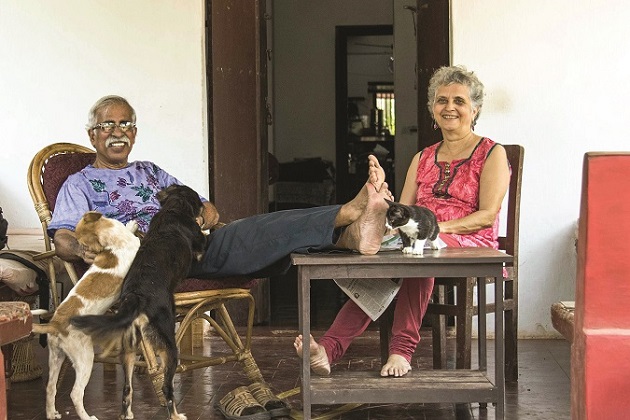
LIFETIME SERVICE AWARD The unstoppable duo of Claude and Norma Alvares have spent their lives fighting social and environmental injustices in the beautiful state of Goa, and continue to shepherd the environmental movement there. Photo Courtesy: Rahul Alvares
The roaring personalities of husband-wife duo Claude and Norma Alvares (also see page 34) epitomise the best of India’s seemingly shrinking intelligentsia. With their keen understanding of ecology, an incomparable commitment to environmental preservation, and laughing irreverence of the status quo, for 40 years the Alvares’ have adroitly shepherded Goa’s environmental movement. The implausible victories they have won along the way, many under the umbrella of the Goa Foundation, have been nothing short of monumental.
A partnership forged during their student years at Mumbai University, turned into a lifetime of social activism. In 1987, they filed the first Public Interest Litigation in Goa for the cancellation of mining leases to extract sand from beaches; in 1992 they were prominent in the successful ‘rebellion’ against American chemical multinational Du Pont, forcing it to retreat; in 1998 the Goa Foundation was nominated to the State’s Coastal Zone Management Authority; and Claude to the Supreme Court’s Committee on Hazardous Wastes; in 1997 and 1998, through the People for Animals-Goa, of which they are founder trustees, they halted the barbarous practices of organised bull fights and dog shooting in Goa; in 2002, they commenced a unique project to rehabilitate a mining site; in 2006, they took over Goa’s largest garbage dump… and within three months cleared it to the extent that they were able to host a tea party at the site; in 2009, they set up a composting unit to deal with fish waste from the Mapusa fish market; and in 2012, they won a prodigious victory when the Supreme Court halted mining in Goa until it could be regulated on the basis of a writ petition filed by their foundation. For close to 15 years, Norma has been a member of the Animal Welfare Board of India and of the National Committee to Control Experimentation on Animals. But these are just the highlights. Alongside this immense body of work, the Alvares’ have written and published books, set up the indie Other India Bookstore, overseen two animal shelters, and mentored dozens of conservationists in their coastal state.
Their harmonious partnership may well be the result of their opposing personalities. Where the sharp-minded Norma is the pragmatic lawyer par excellence who leads the foundation’s legal tussles (she won a Padma Shri in 2002 for her legal work enforcing animal rights), Claude is the maverick philosopher and scholar seeking to decolonise thinking in the global south. Together, the Alvares’ have truly laid a foundation upon which generations of conscientious Indians can stake their environmental battles.
And for this, we honour them.
Wildlife Service Awards
We were in search of inspired wildlifers, forest employees, researchers, villagers... anyone currently involved with in situ nature conservation who have displayed extraordinary courage, dedication and determination and set high personal standards for others to follow.
Varad Giri
Researcher par excellence, Herpetologist, Conservationist

WILDLIFE SERVICE AWARD Researcher par excellence, Varad Giri’s meticulous work has been instrumental in shaping conservation strategies for endemic amphibians and reptiles of the Western Ghats. Photo Courtesy: Varad Giri
Dr. Varad Giri is pushing the boundaries of science, and filling the cavernous gaps in our knowledge of India’s ‘less charismatic’ species. This enables us to formulate effective conservation strategies. Highly skilled and regarded, he prefers to work in the background and is little known to the ‘public’ though people involved with the study and conservation of amphibians and reptiles are in awe of his achievements and for them he is already something of a celebrity. In 2011, the world-famous German taxonomists Dr. Gernot Vogel and Dr. Johan Van Rooijen even named a newly-discovered snake species after him Dendrepahis girii. And how well-deserved that recognition is… after two decades of studying and conserving the endemic amphibians and reptiles in the magical Western Ghats.
Currently a Post-Doctoral Fellow at the National Centre for Biological Sciences (NCBS), Giri earlier worked for over a decade with the iconic Bombay Natural History Society (BNHS), starting off as a Research Assistant and going on to become the Curator and Deputy Director of the Collections Department. All through his life he has endured gruelling field conditions, meticulously surveying remote areas to understand the distribution and classification of little-known species we may be totally unaware of, which are critical to the ecological health of the Indian subcontinent. Expectedly, in the process he has discovered several new species, including snakes, geckos, frogs and caecilians, and his works have been published in innumerable national and international journals of repute. Amongst his laundry list of achievements, the rediscovery of the Jeypore Indian gecko Geckoella jeyporensis after 135 years, the description of 13 new species of frogs of the genus Nyctibatrachus, and the first report of a live-bearing amphibian from Asia, stands out.
Varad’s incredible mind, his ability to infect others with enthusiasm and his willingness to share his expertise, is equipping young researchers with the skills they need to carry forward his work legacy. His humble demeanour merely underscores his vast contribution to conservation in India.
And for this, we honour him.
Nandini Velho
Field Biologist, Communicator, Educator
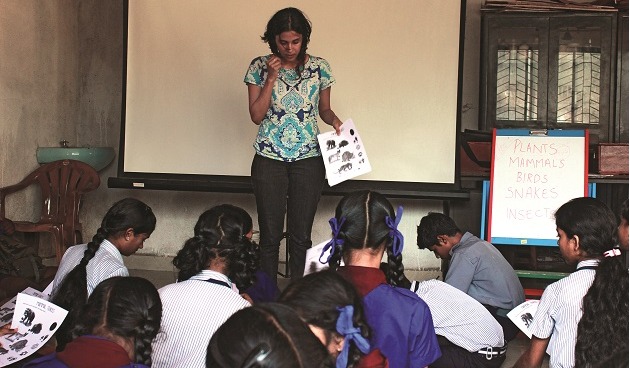
WILDLIFE SERVICE AWARD A fantastic field biologist and articulate communicator, Nandini Velho has seamlessly made conservation and community welfare the prime focus of her work. Photo Courtesy: Hannah Krupa
It’s hard to keep pace with Nandini Velho, a trained field biologist whose prime purpose in life is to protect the biodiversity of the planet. At any given point of time, she could be in Arunachal’s Eaglenest Wildlife Sanctuary, or Pakke Tiger Reserve, Goa, or Bengaluru. Her ‘can-do’ attitude and quick wit, dispels any notion people may have that nature conservation by definition is a dull, thankless and overtly serious occupation. With a Masters degree in conservation biology from the National Centre for Biological Sciences and Wildlife Conservation Society under her belt, she currently awaits her doctoral degree from Australia’s James Cook University.
A perfect blend of curiosity, scientific temperament and wanderlust, Nandini is undoubtedly the face of modern conservation in India. To better understand how policy works (or does not work), she worked as a ‘Policy Fellow’ at the Office of the Ministry of Environment and Forests with Jairam Ramesh, former Minister of Environment and Forests. Working closely with the Forest Department, local community leaders and other NGOs, she was part of a team that organised the first-ever Arunachal Bird Festival at Eaglenest. She has reviewed and helped write Tiger Conservation Plans of important reserves in northeast India. A conservation dynamo, she helped design and create a delightful Nature Interpretation Centre at Pakke, and annually works with children living in village schools around Eaglenest. Reaching out to supportive organisations such as Hemendra Kothari’s Wildlife Conservation Trust, she works with the Forest Department and Dr. Anish Andheria (Director of WCT) to raise funds for uniforms and provisions for as many as 140 frontline, anti-poaching staff of Pakke, the location for the fieldwork that resulted in both her dissertations.
An exceptionally charismatic communicator, Nandini’s writings range from academic journals across the world to popular publications where she expertly breaks down complicated issues into language that laypersons can comprehend. A link between hard conservation, science, and community welfare, Nandini is unstoppable in her quest to win support for wild nature!
And for this, we honour her.
Param jit Singh
Forest officer, Poachers’ nemesis, Team player
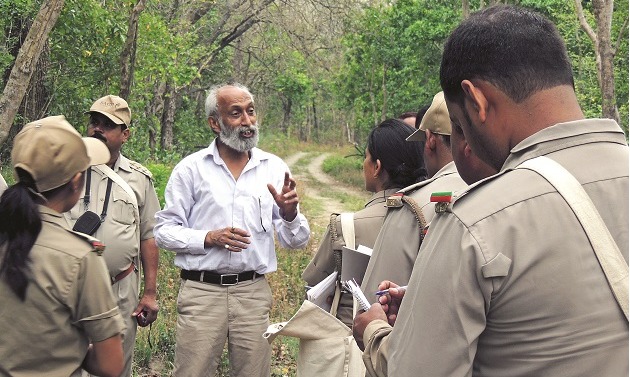
WILDLIFE SERVICE AWARD Param Jit Singh has worked in many capacities within the forest hierarchy bringing about effective changes both on the ground and at a policy level. Photo Courtesy: Param Jit Singh
A geologist by training, Param Jit Singh is an anti-poaching mastermind, instrumental in a series of wildlife contraband seizures in Uttarakhand, including a crackdown on the late Sansar Chand in the early 90s. He has overseen the notification of several little-known, but critical biodiversity habitats including India’s first conservation reserve, the Asan Wetland Conservation Reserve. the Nandhaur Wildlife Sanctuary, the Naina Devi Bird Conservation Reserve, and the Pawalgarh Conservation Reserve. He also pioneered a 24x7 forest helpline called Van Mitra, an automatic ‘cloud’ call-centre that empowers citizens to report wildlife crimes.
Steely-eyed, and instantly purposeful, Pammiji, as he is affectionately called by friends and colleagues up and down the forest hierarchy, has that certain je ne sais quoi that makes a good forest officer great. In his three decades of service in Uttarakhand, he has held office as the Chief Conservator of Forests, Wildlife Administration and Intelligence, Uttarakhand, Chief Conservator of Forest, Kumaon, Divisional Forest Officer, Shivalik, State Director of Anti-poaching, Nodal Officer for Wireless Networking, the Director of the Nanda Devi Biosphere Reserve, including Valley of Flowers National Park and Nanda Devi National Park and presently CEO of the Compensatory Afforestation Fund Management and Planning (CAMPA).
Never one to sit too long at his desk, Singh is one of those extremely rare and invaluable breed of officers, who actually enjoy the rigours of the field. In his words, “If my staff can do it, so can I.” This includes trekking miles on anti-poaching patrols, surveying rough terrain for habitat management initiatives to help create corridors and buffers for wildlife, and training staff. Popular and instantly personable, he has created a vast network of informants that is purposefully hitting back at the dangerous wildlife-crime nexus that takes such a vicious toll on wildlife across India.
A thinker and a doer, Param Jit Singh realises that without the support of local communities the effectiveness of biodiversity conservation will be temporary at best. His no-nonsense charm wins him much support, at both the local and national level and all this he uses to protect the wildlife that has become the purpose of his life.
And for this, we honour him.
Dr. Yash Veer Bhatnagar
Mountain man, Scientist, Mentor
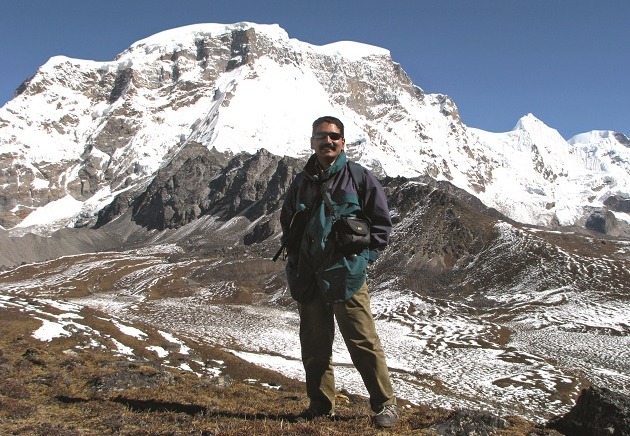
WILDLIFE SERVICE AWARD Dr. Yash Veer Bhatnagar’s work in India’s high Himalaya has been pivotal to conservation and research in these cold landscapes. Photo Courtesy: Dr. Yash Veer Bhatnagar
Dr. Yash Veer Bhatnagar is a mountain man, most at home in the icy environs of Spiti and other high-altitude habitats that support such elusive and charismatic creatures as snow leopards, markhor, marmots and red foxes. Far from the tropical forests most associated with Indian wildlife, the icy wildernesses of Asia’s cold deserts hold a bewildering diversity of wild species whose very existence lies threatened not only by local pressures, but also on account of galloping climate change.
As the Director of the Snow Leopard Trust’s India Programme, and Co-director of the Nature Conservation Foundation’s High Altitude Programme, for over a decade, Bhatnagar is without doubt a key solution provider for India’s high-Himalaya conservation strategy.
It was in pursuit of his PhD thesis between 1991 and 1996 that he first began to study the ecology of the Asiatic ibex. This broke new ground, for no similar long-term studies had ever been conducted anywhere in the world on this species. In 1998, he realised that protecting high-altitude flora and fauna was impossible without the participation, support and involvement of locals who often had to pay the highest price for wildlife conservation by way of lost livestock. His team’s conflict-management strategy in Ladakh’s remote Markha valley soon drew the attention of several scientists and within a year he found himself organising a path-breaking, multi-dimensional exploration of Ladakh that drew together an unprecedented 15 scientists and researchers of the Wildlife Institute of India. He never looked back.
Currently considered to be one of the world’s most authoritative ungulate specialists, Dr. Bhatnagar has walked the rough trails taken by ibex, Tibetan gazelle and kiang, so as to throw light on their ecological imperatives. He has also overseen studies conducted by scientists on urial, markhor, argali, bharal and other such high-altitude species. A great believer in the principle of ‘convergence of goals’, he is currently working to scale up conservation efforts in remote, mountainous areas so as to offer communities livelihoods based on the protection of, rather than the unsustainable exploitation of wildlife.
It was his team that conceptualised the ‘4 E’ approach, basing strategies on ecology, energy, education and enterprise to ensure holistic participatory conservation in the 4,000 sq. km. upper Spiti landscape. Among the many committees that seek his advice and involvement is the National Snow Leopard Ecosystem Priorities (NSLEP) for the Global Snow Leopard Forum, whose mission he helped draft. He has also been part of other landscape-based conservation programmes in Ladakh, Kashmir, Sikkim and Arunachal Pradesh.
Humble, persistent, innovative, Dr. Bhatnagar exemplifies nuanced conservation biology that works with and for both species and local communities.
And for this, we honour him.
The Gir Lion Protection Team
Committed, Tireless, Dynamic
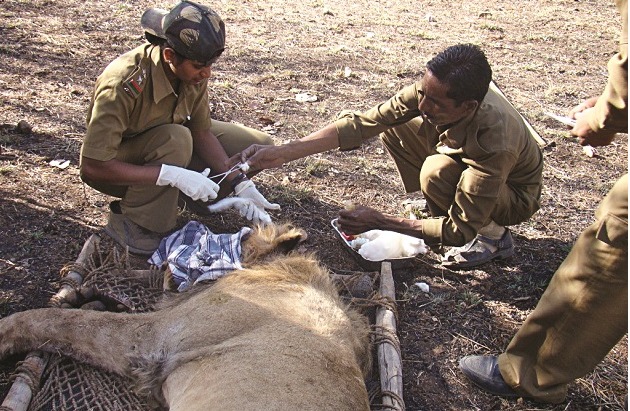
WILDLIFE SERVICE AWARD These brave foresters and forest guards have drafted one of the world’s most successful conservation chapters – protecting the planet’s last Asiatic lion population in the Gir Wildlife Sanctuary and National Park. Photo Courtesy: Gir Forest Department
The extraordinary men and women who serve as foresters and forest guards of the Gir Wildlife Sanctuary and National Park in Gujarat are the gatekeepers of one of India’s most successful conservation stories – the thriving well-being of the planet’s last population of Asiatic lions. They are rescuers, habitat managers, tourism regulators, skillful trackers and, most importantly, peacekeepers of the volatile relationship between park authorities and the neighbouring communities.
Representing this team are three of its most highly respected and dynamic members. Known as ‘the lion queen’ of India, forester Rasila Vadher’s legendary exploits could fill a book. The leader of the department’s wildlife rescue division, the fearless Vadher has plunged into the depths of a well to rescue a leopard, tranquilised lions from seemingly impossible angles, smoothly shifted venomous snakes from inside houses, and participated in over 800 successful rescue operations. Completely at ease in the forest, intensely committed to the protection of wildlife, she stands strong in the face of danger…and then subdues it.
Quiet and untiring, forest guard M. A. Rayjada is a much cherished member of the department. In a career that spans close to a decade, he has provided crucial assistance in sensitive operations more times than can be counted. Most notably, in 2008, when 2,000 irate villagers tried to enter the forest without permission, he single-handedly pacified the mob, preventing damage to department property and potentially saving lives.
Despite being a victim to violent attacks at numerous points in her career, Madhu Karengia’s dedication to her job as a forester has never even momentarily faltered. Karengia has cleared over
36 ha. of encroachment into the forest, made arrests on offences of illegal entry and unauthorised grazing, and followed through with the collection of fines, and even lends a hand in the rearing of orphaned wildlife.
The protectors of Gir are Earth heroes…
And for this, we honour them.
Green Teacher Award
We were in search of an individual with missionary zeal and a proven environmental track record, who set an example for other educators to follow.
Anurag Kumar
Wildlife protector, Educator, Innovator
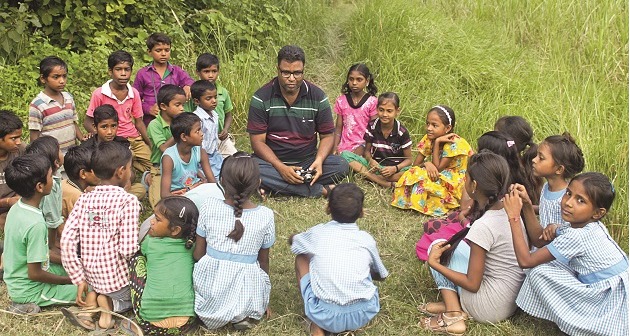
GREEN TEACHER AWARD Children from Bansinagar village on the edge of Dudhwa Tiger Reserve voluntarily attend a free nature education school conceptualised by wildlife enthusiast Anurag Kumar. Photo Courtesy: Anurag Kumar
In early spring, the sugarcane in the fields on the edge of the Dudhwa Tiger Reserve stand a little less than two metres high. Near impenetrable, the sweet stalks dwarf the dozens of children who stream from Bansinagar village to a small clearing in these fields every evening. Here, the children will pull rugs and books out of a small building and settle down under the generous canopy of an aged peepal tree, or perhaps collect a large jute sack and head out into the buffer forests to collect litter left by ignorant tourists.
Eight years ago, Lucknow-based wildlife protector Anurag Kumar set up camp in this little clearing, which served as a base for his tryst with destiny. In the evenings, when he would return to his base, children from the neighbouring village would flock to him, asking to see pictures of wildlife. As his bond with these children grew, Kumar found himself compelled to channel their curiosity towards conservation, and so he conceptualised a free nature education school for rural children under the name of Vision Dudhwa.
In the half decade since Kumar started his school, not only has he constructed a small two-room centre, built a library of wildlife books and movies, hired a teacher and a caretaker, but his unorthodox, hands-on approach, has also ensured that the 35-odd children voluntarily land up for ‘nature school’ every evening after their government school hours. Their ‘syllabus’ comprises everything from moral studies and birdwatching, to wildlife rescue and litter collection in the buffer of the reserve. Special occasions are celebrated with great fervour – and the entire school gathers for meals and performances. The students are largely children of landless farmers, and through the school, Kumar regularly supplies them with essentials like warm clothes, stationary and the occasional nutritious treat.
How does he fund this? Kumar, who grew up in Lakhimpur Kheri where he nurtured his love for nature, spends almost 30 per cent of his salary from his job with the Uttar Pradesh Power Corporation Limited on running the school. What shortages arise are met by wildlife supporters who follow his work through a Facebook page.
As testament to his teaching methods, many of the students who have outgrown the school, regularly return to mentor their juniors and help the staff. Kumar has now started a similar project in a Tharu village on the Indo-Nepal border. By nurturing the young minds that live closest to our wildernesses, Anurag Kumar has triggered positive change in a ‘ripple-effect’ that flows from children to parents to the Forest Department.
And for this, we honour him.
Young Naturalist Awards
We looked for young naturalists or conservationists, for whom the study and defense of nature is the purpose of life, whose actions speak louder than words and who inspire hope for the future.
Viral Joshi
Wildlife recordist, Wildlife rescuer, Educator
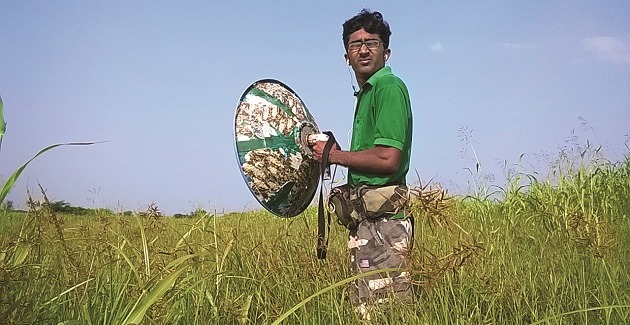
YOUNG NATURALIST AWARD Often using personally-invented recording equipment, Viral Joshi has recorded over 500 different Indian bird calls in the country, and made them available without copyright on xeno-canto, a global birdsong online database. Photo Courtesy: Viral Joshi
India has a huge asset in young Viral Joshi, who is destined to be one of India’s finest ornithologists. At first his resume reads rather commonplace – a Bachelors’ degree in psychology, a certificate in M.S. Office, and another in hardware and software networking. Scroll further down and you get to know the real Viral – the one that has some of the country’s most eminent birders knocking with increasing frequency on his door.
A skilled naturalist, Viral is, poetically put… a connoisseur of birdsong – able to identify dozens of avian species through little more than their lilting (or for that matter harsh) calls. Often using personally-invented recording equipment, he has managed to record over 500 different Indian bird calls in the country, and made them available without copyright on xeno-canto, a global birdsong online database. That’s not all. Using their calls he has added to the bird list of Saurashtra, incorporating difficult-to-identify species including the Bristled Grassbird and the Grasshopper Warbler.
At 22, Viral is already a veteran lecturer, regularly relied upon by the Gujarat Forest Department to help with capacity building within their ranks. He has also assisted important bird studies, most recently the Gujarat vulture survey. Willingly volunteering for wildlife rescue and rehabilitation missions, he works with snakes with the same facility as he does birds.
Rooted in rural Gujarat, his lack of ‘scientific background’ has not stopped him from mastering nuanced ecological theories in English. Nor have his commitments to natural history studies stopped him from following his own dream projects. Viral Joshi is a remarkable young man, an asset to bird studies and conservation.
And for this, we honour him.
Sailaja Nayak
Braveheart, Field biologist, Conservationist
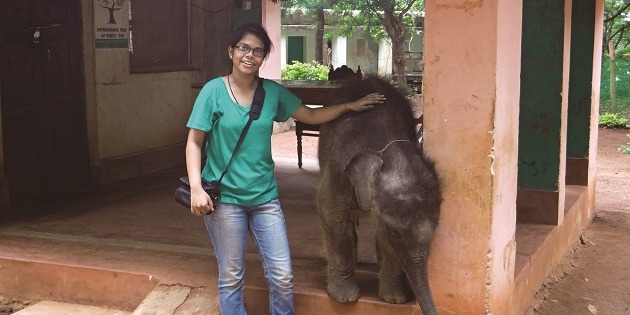
YOUNG NATURALIST AWARD Sailaja Nayak has surmounted arduous field conditions and language barriers to work with big cats across the country. Photo Courtesy: Sailaja Nayak
She works with big cats across the country. And she is driven and here to stay. In 2012, WWF-India took on six volunteers to help estimate prey density in the forbidding Pakke Tiger Reserve. Three months later, just one volunteer remained – Sailaja Nayak. The conditions were tough, but Sailaja was tougher.
At 25, she has already worked in Pakke, Kanha, Pench and Ranthambhore. Arduous field conditions and language barriers have not deterred her. Using camera-traps across an area of
3,000 sq. km. in northwest India, she has identified three tigers that left Ranthambhore to seek new territory out of the Protected Area.
Personable and sensitive to both local community and Forest Department imperatives, Sailaja has helped to fortify the little-known corridor extending from Ranthambhore to Kuno (the chosen home for Gir lions that haven’t made it there yet). In the process, she created intelligence networks in the Kailadevi and Kuno Wildlife Sanctuaries that alert her to potential threats to wildlife before crimes take place, allowing preventive action that saves the lives of big cats.
Sailaja’s fieldwork has resulted in the publication of papers and beefing up of records, and revealed the very first authentic sighting of a rusty spotted cat in Rajasthan’s Ramgarh Vishdhari Wildlife Sanctuary. While focusing on tiger ecology and biology, Sailaja also managed to work on the interaction between wolves and hyaenas on kills in the Kailadevi Wildife Sanctuary, near Ranthambhore, and the food habits of the Indian giant squirrel in Kapilash Wildlife Sanctuary, which was her Masters’ dissertation.
A perfect blend of conservation biology, sociology and sheer passion for wildlife, this young woman represents the future of wildlife conservation in India.
And for this, we honour her.
Virendra Singh Panwar
Nature guide, Wildlife lover, Protector
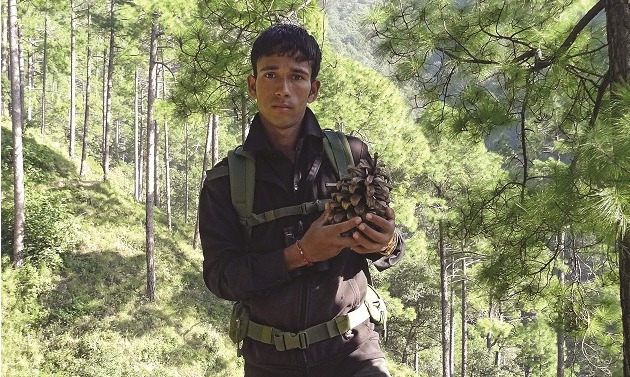
YOUNG NATURALIST AWARD Twenty-one-year-old nature guide Virendra Singh Panwar is a committed conservationist who works in the Jabarkhet Nature Reserve, Uttarakhand. Photo Courtesy: Virendra Singh
Soft-spoken, but smitten by nature, this young lad from Kolti village in the Garhwal Himalaya must walk seven kilometres just to reach a motorable road from where he must travel another five kilometres to get to the college that he believes is his gateway to the future. When not trudging a quarter of a hundred kilometers to college and back, he tramps the paths of ‘his’ forest, to earn a modest livelihood as a nature guide.
At 21, clearly his adventures have only just begun. The management of the private Jabarkhet Nature Reserve was unsure of his commitment when they took him on as a nature guide. But in the one year since they took a ‘gamble’ on him, Viru has laid all apprehensions to rest, rapidly picking up the basics of field identification, camera trapping, and photography, helped along by little more than a guidebook on the flora of the Himalaya, a CD of birdcalls, a second-hand laptop, a pair of binoculars and a basic camera. Grabbing every opportunity to attend naturalist training camps organised by the Uttarakhand Forest Department, he hungrily absorbed lessons that served to hone his skills. Today, he has already turned into more than a naturalist that most visitors might take for granted. Combining his native knowledge of the forest with his newly developed skills, he eagerly shares this with visitors and equally learns new things from them.
Each wild denizen of Jabarkhet has a friend in Viru. This year when he discovered a Khaleej Pheasant nest with as many as nine eggs in it, he made it his mission to ensure that no one approached the nest. His carefully-placed camera traps recorded a leopard cat with two kittens and Viru still looks upon them as family. Proud of this natural heritage, committed to his job, he is an inspiration to young people in this Himalayan community and is working to win their support for total involvement in protecting the wilds he knows are vital to the health and happiness of his people.
And for this, we honour him.
Wind Under the Wings Award
We looked for an organisation that had enabled an employee, or had supported someone to defend nature by making resources available and by providing the intellectual space for them to follow their own green mission.
Jayan Menon and Malayala Manorama
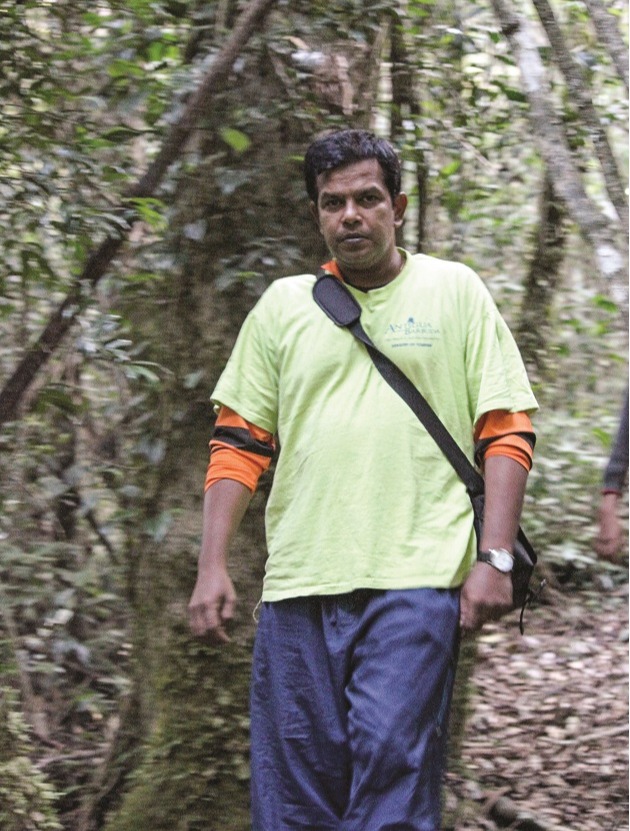
WIND UNDER THE WINGS AWARD Jayan Menon’s reportage on elephant poaching and ivory trade in Kerala resulted in the arrest of 42 individuals. Photo Courtesy: Jayan Menon
On July 28, 2015, Kerala’s largest circulating daily, Malayala Manorama, published an exposé that blew the lid off the state’s Machiavellian, illegal ivory mafia. Their Chief Reporter Jayan Menon had uncovered a story of elephant poaching and ivory trade so scandalous and grim, that within four months, 42 individuals were arrested in the case. Menon’s initial report revealed that within a year, over 40 elephants were slaughtered in Kerala’s Western Ghats for their tusks. The further revelation that this large-scale poaching was enabled by the apathy as well as criminal connivance of officialdom served to fuel the issue. Menon’s report in Malayala Manorama and the ensuing uproar forced the state government to turn the case over to the Central Bureau of Investigation, and led to the formation of an inter-state coordination committee to monitor elephant poaching in India’s southern states.
Starting out as a sports journalist, Jayan gradually gravitated to investigative journalism, and for the past nine years his byline has become synonymous with hard-hitting, public interest stories. Through these years, he’s nurtured an interest in wildlife, and as early as 1997 he was covering the ivory trail of the bandit Veerapan.
No stranger to accolades, Menon has previously been awarded the G. Venugopal Award of the Thiruvananthapuram Press Club, the Kerala Government’s Safety Award, and the V. K. Madhavankutty award amongst many others. However, this year’s impactful reportage by Menon and its publication by Malayala Manorama has raised the standards for regional reporting on conservation issues in the country.
And for this, we honour them.
Anahita Mukherji and The Times of India
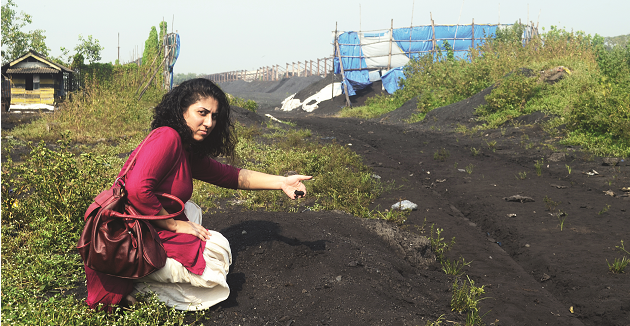
WIND UNDER THE WINGS AWARD Environmental reporter Anahita Mukherji uncovered the health hazards of the 1,50,000 metric tonnes of coal lying in the open on Mumbai’s Eastern seafront. She continues to fight against this unauthorised open coal field. Photo Courtesy: Anahita Mukherji
With 10 years of reporting on public interest issues under her belt, Times of India’s Anahita Mukherji expertly marries tenacity to activism, and activism to writing. A graduate of the School of Oriental and African Studies in London, Mukherji has carved a niche for herself as an exceptional environmental reporter. One who is unafraid of invoking the ire of the powerful interest groups that she methodically exposes.
For the past year, Mukherji has doggedly followed the devastating impacts of 1,50,000 metric tonnes of coal lying in the open on Mumbai’s Eastern seafront. Not only has she documented the grave health hazards to those that live and work around these ‘coal mountains’, she has also consistently followed up on a High Court petition filed by activists seeking to prevent the Maharashtra Pollution Control Board from giving its “consent to operate” to the Mumbai Port Trust to handle coal, and revealed the manner in which the pollution board has neglected its duties.
After TOI’s sustained coverage of the issue, the Mumbai Port Trust released a public notice stating that it would stop handling coal by the third week of September and clean the entire area of coal by October 30. However, under duress from vested interests the port trust wrote to the Pollution Control Board seeking a fresh consent order. Mukherji went on to slam the board for, once again, agreeing to allow the Port Trust to handle coal. While the issue continues to burn, Mukherji critiques the government’s apathy and vows to keep writing till the coal is moved out of Mumbai once and for all.
For her incorruptible values and extraordinary perseverance to cover a neglected but crucial story, Anahita Mukherji and Times of India have proved to be a fighting force for Mumbai’s ecological health.
And for this, we honour them.
SPECIAL MAHARASHTRA WILDLIFE SERVICE AWARDS
Unrelenting forest officers, Persistent community members, Brave foot soldiers
Uttam Sawant
 Photo Courtesy: Uttam Sawant.
Photo Courtesy: Uttam Sawant.
Assistant Conservator of Forests, Pench Tiger Reserve, 34-year-old Sawant has, in just four years, affected revolutionary changes in four Protected Areas of Maharashtra, including Pench, Umred-Karhandla, Bor and Tipeshwar. His enthusiastic, hands-on approach to conservation, community outreach and research, has paid rich dividends, visible in the thriving populations of wildlife wherever he works. Whether joining his staff on foot patrol, facilitating village rehabilitations, radio-collaring tigers, or regulating tourism, Sawant has proved to be the kind of all-rounder that every Protected Area needs in its ranks.
And for this, we honour him.
Umesh Verma
 Photo Courtesy: Umesh Verma.
Photo Courtesy: Umesh Verma.
The Deputy Conservator of Forests of Melghat Tiger Reserve’s Akot Wildlife Division, Umesh Verma has pioneered several superb initiatives in his territory. He has guided the relocation of five villages from Melghat’s core area, established 12 grazing meadows for wildlife in the cleared sites, invested considerable time and energy in soil moisture conservation, and consistently worked to win the support of the local communities. Hardworking and untiring, Umesh Verma is an admirable leader.
And for this, we honour him.
N. Vasudevan
 Photo Courtesy: N. Vasudevan.
Photo Courtesy: N. Vasudevan.
A member of the Indian Forest Service, N. Vasudevan is the Chief Conservator of Forests, Mangrove Cell, Mumbai, and has the intimidating task of managing Maharashtra’s mangroves. With a Masters in marine biology and public policy and management, Vasudevan rises skillfully to the challenge, despite being understaffed. His impressive handling of tricky situations, such as stranded dolphins and beached whales, steadfast work towards mangrove preservation and revival, and cooperative attitude towards researchers and conservationists, have won him the respect of all who work with him.
And for this, we honour him.
Purnima Upadhyay, KHOJ and the Gram Sabha of Payvihir village
 Photo Courtesy: KHOJ.
Photo Courtesy: KHOJ.
Encouraged by the NGO Khoj, the villagers of Payvihir, lead by Ramlal Kale, embraced the spirit of the contentious Forest Rights Act (2006), and forged an incredible, uplifting story of community conservation. In place of the 182 ha. of degraded land that the village was handed as part of their Community Forest Rights now stands a flourishing forest. Through soil and water conservation, afforestation, regulations on cattle grazing and forest produce extraction, the gram sabha of the village not only reinvigorated the region’s biodiversity, but also tackled problems of unemployment and migration by providing jobs to locals. Their astute management of natural resources and their persistent commitment to the land has been no less than illuminating.
And for this, we honour them.
Kailash Hudme, Laxman Aware, and Govinda Luche, Gothangaon
Photo Courtesy: UKTR Forest Dept.
Is a mutually-beneficial alliance between forest authorities and communities just a myth? The relationship between Kailash Hudme, the Gram Pradhan of Gothangaon village, and two Range Forest Officers of the adjacent Umred-Karhandla Sanctuary, Laxman Aware and Govinda Luche, proves otherwise. Together, these three exceptional men ensured that landowners in Gothangaon turned their farmland over to wildlife in a unique rewilding exercise. The project sets a national precedent, and benefits both communities and tigers. Living closest to these apex predators, they have undertaken a monumental task with infinite sensitivity and finesse.
And for this, we honour them.
Sanctuary Legend
Ashok Kumar
Photo Courtesy: Irani Saikia/WTI.
It is rumoured that in his lifetime, infamous tiger parts-trader Sansar Chand was only ever fearful of a handful of people, of whom Ashok Kumar (http://www.sanctuaryasia.com/people/interviews/9618-meet-wildlife-trust-of-indias-abiding-hero-ashok-kumar.html) was one. One of the pioneers of the fightback against wildlife crime in India, Ashok Kumar’s purpose, and intellect helped, early in the day, to mould some of the country’s finest wildlife organisations, including TRAFFIC-India, the Wildlife Protection Society of India and the Wildlife Trust of India, of which he is currently the Chairman Emeritus. Working undercover in the field, and on the all-important subsequent legal follow-up proceedings, he tracked and exposed innumerable wildlife crimes, including, but far from limited to, poaching and the trade in ivory, rhino horn, and shahtoosh. A man of profound foresight, Ashok Kumar’s purpose and legacy will live on through the institutions he helped establish and the army of credible conservationists he personally mentored.














 Photo Courtesy: Uttam Sawant.
Photo Courtesy: Uttam Sawant. Photo Courtesy: Umesh Verma.
Photo Courtesy: Umesh Verma. Photo Courtesy: N. Vasudevan.
Photo Courtesy: N. Vasudevan. Photo Courtesy: KHOJ.
Photo Courtesy: KHOJ.
